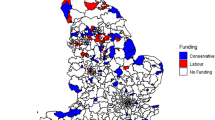Conclusions
Statistical analysis tends to support the view that quid-pro-quo fiscal arrangements reduce rent-seeking opportunities and thereby limit campaign spending in gubernatorial races. This investigation has, however, not examined other possible avenues of rent-seeking, nor has it tested the hypothesis that earmarking forces a global reduction in rent-seeking activity. One possibility, already discussed, is that higher taxes may reduce participation in gubernatorial elections but increase the demand for tax advisers. Nor have we considered rent-seeking at different levels within government — within the legislature or the highway bureaucracy, for example. Finally, we have not examined rent-seeking at those critical quasi-constitutional moments when earmarking rules are being established. Because rent-seeking can occur on many different levels, these issues deserve further investigation.
Of some interest is the statistical insignificance of several variables commonly thought to contribute to campaign activity, including the income of citizens, and the candidate's political PARTY and TERM of office. Our findings downplay the importance of those variables once the distinction is made between quid-pro-quo and unilateral government transactions.
Buchanan's view that rent-seeking tends to increase in direct proportion to government spending gains support here, after controlling for earmarking and other conditions that influence campaign spending. Accordingly, a 1% increase in non-QPQ spending stimulates a 1% increase in campaign activity. The positive coefficient on GOVernment spending and the negative coefficient on TAXes imply that campaign contributions and SPENDing grow in conjunction with larger public deficits — an ominous sign in an age of contribution-maximizing candidates. More optimistically, our empirical results also suggest that earmarking and other quid-pro-quo fiscal arrangements may be among the institutional reforms most effective at limiting growth of the rent-seeking society.
Similar content being viewed by others
References
Bender, B. (1986). The determinants of relative political campaign expenditures. Economic Inquiry 24: 231–256.
Buchanan, J.M. (1980). Rent-seeking and profit seeking. In: J. Buchanan, R.D. Tollison and G. Tullock (1980), Toward a theory of the rent-seeking society. College Station: Texas A&M University Press.
Buchanan, J.M., Tollison, R.D., and Tullock, G. (1980). Toward a theory of the rent-seeking society. College Station: Texas A&M University Press.
Congressional Quarterly (1979). Congressional Quarterly Weekly Report (25 August): 1756–1757.
Council of State Governments (1980). The book of the states, 1980–1981. Lexington, KY: Council of State Governments.
Crain, M., and Tollison, R.D. (1977). Attenuated property rights and the market for governors. Journal of Law and Economics 20: 205–211.
DiLorenzo, T.J. (1984). The domain of rent-seeking behavior: Private or public choice? International Review of Law and Economics 4: 185–197.
Hunter, W., and Scott, C. (1986). Interstate differences in individual income taxes. Public Finance Quarterly 14: 69–85.
Montana Office of the Legislative Fiscal Analyst (1980). Montana's dedicated revenues in relation to dedicated revenues in other states. Helena, Montana.
Sabato, L. (1983). Goodbye to good-time Charlie. Washington, DC: Congressional Quarterly.
Stigler, G. (1971). The theory of economic regulation. Bell Journal of Economics 2 (Spring): 3–21.
Tax Foundation (1965). Earmarked state taxes. New York: The Tax Foundation.
Tullock, G. (1967). The welfare costs of tariffs, monopolies, and theft. Western Economic Journal 5 (June): 224–232. Reprinted in J.M. Buchanan, R.D. Tollison and G. Tullock (1980), Toward a theory of the rent-seeking society. College Station: Texas A&M University Press.
Tullock, G. (1980). Efficient rent-seeking. In: J.M. Buchanan, R.D. Tollison and G. Tullock (1980), Toward a theory of the rent-seeking society. College Station: Texas A&M University Press.
Author information
Authors and Affiliations
Rights and permissions
About this article
Cite this article
Wyrick, T.L., Arnold, R.A. Earmarking as a deterrent to rent-seeking. Public Choice 60, 283–291 (1989). https://doi.org/10.1007/BF00159398
Issue Date:
DOI: https://doi.org/10.1007/BF00159398




